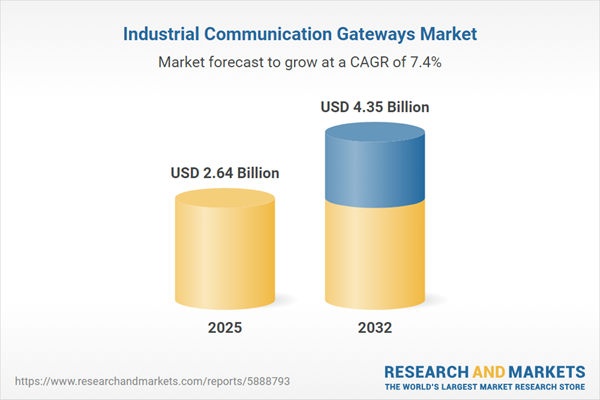Speak directly to the analyst to clarify any post sales queries you may have.
The industrial communication gateways market plays a strategic role in enabling seamless integration between operational technology and information technology across manufacturing and energy sectors. Senior decision-makers focused on scaling digitalization and future-proofing industrial infrastructure will find this market at the intersection of connectivity, interoperability, and secure data transfer.
Market Snapshot: Industrial Communication Gateways
According to recent research, the industrial communication gateways market is experiencing robust expansion, having grown from USD 2.46 billion in 2024 to USD 2.64 billion in 2025. The market is projected to reach USD 4.35 billion by 2032, driven by a compound annual growth rate (CAGR) of 7.39%.
Scope & Segmentation
This report delivers a granular analysis of the global industrial communication gateways market, providing actionable insights into technologies, deployment scenarios, and end-user industries. The study segments the market as follows:
- Component: Hardware (Edge Routers, Gateway Devices, RTUs), Services (Consulting, Installation, Maintenance), Software (Analytics Software, Firmware, Middleware)
- Deployment Mode: Cloud (Multi Cloud, Private Cloud, Public Cloud), Edge (Device Edge, Network Edge, Server Edge), Hybrid, On Premise (Enterprise Data Center, Hosted Private Cloud)
- Application: Asset Management (Inventory Management, Performance Optimization), HMI (Local HMI, Web HMI), Predictive Maintenance (Oil Analysis, Thermal Imaging, Vibration Analysis), Remote Monitoring (Condition Monitoring, Environmental Monitoring), SCADA (ICS SCADA, Power SCADA)
- Industry Vertical: Automotive (Assembly, Auto Suppliers, OEM), Energy & Utilities (Power Generation, Renewable Energy, Transmission & Distribution), Manufacturing (Discrete Manufacturing, Process Manufacturing), Oil & Gas (Downstream, Midstream, Upstream), Pharmaceuticals (Biotech, Generics, Research Labs)
- Communication Protocol: Ethernet IP (CIP, DLR), Modbus TCP, MQTT (MQTT SN), OPC UA (Binary, UA Pubsub, XML), Profinet (IRT, RT)
- Connectivity Type: Bluetooth, Fieldbus, LPWAN, Serial, WiFi
- Region: Americas (United States, Canada, Mexico, Brazil, Argentina, Chile, Colombia, Peru), Europe Middle East & Africa (United Kingdom, Germany, France, Russia, Italy, Spain, Netherlands, Sweden, Poland, Switzerland, United Arab Emirates, Saudi Arabia, Qatar, Turkey, Israel, South Africa, Nigeria, Egypt, Kenya), Asia-Pacific (China, India, Japan, Australia, South Korea, Indonesia, Thailand, Malaysia, Singapore, Taiwan)
- Leading Companies: HMS Networks AB, Moxa Inc., Cisco Systems, Inc., Siemens Aktiengesellschaft, Schneider Electric SE, Advantech Co., Ltd., Belden Inc., Phoenix Contact GmbH & Co. KG, Rockwell Automation, Inc., ABB Ltd
Key Takeaways: Strategic Insights for Senior Leaders
- Industrial communication gateways serve as the foundation for interoperability, connecting diverse equipment and enabling real-time data exchange across digital factories and smart energy networks.
- Rapid adoption of industrial IoT and edge computing increases demand for gateways with advanced analytics and robust security, enabling remote monitoring and efficient asset management.
- The convergence of wired technologies with wireless, including 5G and LPWAN, boosts deployment flexibility, while modular designs offer resilience against evolving operational requirements.
- Regulatory compliance and cybersecurity are critical, with industry standards driving the adoption of gateways featuring embedded encryption and authentication protocols.
- Strategic partnerships among vendors, integrators, and service providers are reshaping competitive dynamics, supporting end-to-end lifecycle management and faster time-to-value for industrial buyers.
Tariff Impact: United States Tariff Developments for 2025
Heightened US tariffs in 2025 are raising the procurement cost of key gateway components such as semiconductors and wireless modules. Manufacturers are responding by diversifying supplier networks, exploring nearshoring options, and investing in modular architectures. These moves aim to mitigate cost pressures and support strategic resilience, while the complexity in supply chain compliance and trade regulations is prompting organizations to enhance transparency and proactive sourcing practices.
Methodology & Data Sources
This analysis combines rigorous secondary research from industry reports, regulatory documents, and technical literature with primary insights gathered from interviews with executives, technical specialists, and end users. Mixed-method validation ensures in-depth, accurate perspectives on segmentation, technology adoption, and strategic market shifts.
Why This Report Matters
- Provides senior decision-makers with segment-level intelligence to inform CAPEX planning, technology selection, and operational risk assessment.
- Enables benchmarking against market leaders and emerging innovators in connectivity, cybersecurity, and industrial automation.
- Supports adaptation strategies for navigating regulatory and trade-related disruptions in global supply chains.
Conclusion
Strategic investments in secure, interoperable industrial communication gateways are key to advancing digital transformation. This report empowers industry leaders with actionable intelligence to drive resilient, future-ready operations.
Additional Product Information:
- Purchase of this report includes 1 year online access with quarterly updates.
- This report can be updated on request. Please contact our Customer Experience team using the Ask a Question widget on our website.
Table of Contents
3. Executive Summary
4. Market Overview
7. Cumulative Impact of Artificial Intelligence 2025
Companies Mentioned
The companies profiled in this Industrial Communication Gateways market report include:- HMS Networks AB
- Moxa Inc.
- Cisco Systems, Inc.
- Siemens Aktiengesellschaft
- Schneider Electric SE
- Advantech Co., Ltd.
- Belden Inc.
- Phoenix Contact GmbH & Co. KG
- Rockwell Automation, Inc.
- ABB Ltd
Table Information
| Report Attribute | Details |
|---|---|
| No. of Pages | 197 |
| Published | October 2025 |
| Forecast Period | 2025 - 2032 |
| Estimated Market Value ( USD | $ 2.64 Billion |
| Forecasted Market Value ( USD | $ 4.35 Billion |
| Compound Annual Growth Rate | 7.3% |
| Regions Covered | Global |
| No. of Companies Mentioned | 11 |









